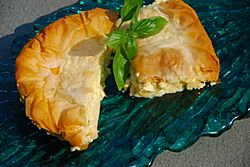Tiropita facts for kids

Tiropita with garnish.
|
|
| Place of origin | |
|---|---|
| Main ingredients | phyllo, eggs, cheese |
Tiropita (say "tee-RO-pee-tah") is a delicious Greek pastry. Its name means "cheese-pie" in Greek. It is made with many thin layers of dough called phyllo. Inside, it has a yummy filling of cheese and eggs.
You can find Tiropita in different shapes. Sometimes it's a small, individual pastry. Other times, it's a big pie that is cut into slices.
If Tiropita is made with a special Greek cheese called kasseri, it might be called kasseropita.
There's also a version called Spanakotiropita. This one has both spinach and cheese inside. It's similar to another popular Greek dish called spanakopita.
The History of Tiropita
Layered pastries like Tiropita have a long and interesting history. Some people think they came from flat, layered breads. These breads were made by Turkish people in Central Asia a long, long time ago.
Other experts believe Tiropita comes from ancient Greek and Byzantine recipes. There was a famous ancient Greek cake called placenta cake. This cake was also made with layers and had cheese in it.
A recipe from around 160 BC describes how to make this ancient placenta cake. It involved putting layers of dough with a cheese and honey mix in between. Then it was baked and honey was poured over it.
Even today, in some languages like Aromanian and Romanian, the word for a flat baked pie with cheese is similar to "placenta."
See also

- In Spanish: Tiropita para niños

